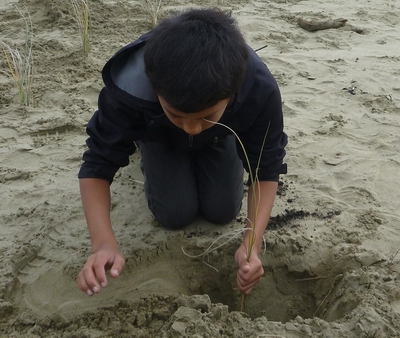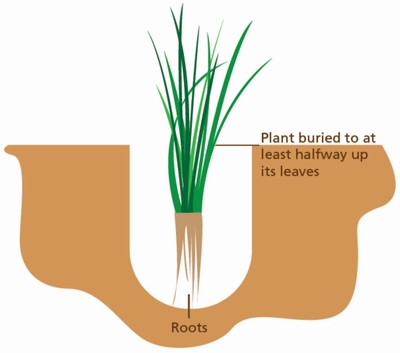Planting guidelines
Preparation for planting
- Get land-owner permission before starting any planting projects.
- Historic site? Check site for signs of early human occupation. Shell middens are present on some Northland dunes usually easily identified as dense layers of shells. You need permission from the New Zealand Historic Places Trust before disturbing any archaeological sites. If you are not sure it is best to check first.
- Plan where and what to plant. Contact Northland Regional Council for advice on dune restoration projects and always choose plants that grow naturally in the zone you will be planting
- Control weeds. On mid-dune and back-dune sites, spot-spraying of dense exotic grasses before planting will reduce smothering of newly established seedlings.
- Utilise shelter. Wherever possible on mid-dune and back-dune sites, plant natives in sheltered spots amongst any existing vegetation cover.
Sourcing plants
- Source local plants where possible. Plants grown from locally-collected seeds or cuttings are better adapted to the local climate and conditions.
- Ask the land-owner first before taking any plant material.
Planting
- Plant between May and September. Avoid planting in the hotter and often drier late spring to early autumn period.
- Use fertiliser. Give plants a good start with a slow-release nitrogen-based fertiliser – tablets are convenient to use.
Maintaining planted areas
- Keep on top of weeds to prevent seedlings from being over-run.
- Keep up the animal pest control to prevent plants from being eaten.
- Replant as required if plants are lost due to erosion and die-off.
For more information on planning and maintaining a weed control programme, see the Northland Regional Council factsheet Weed control on sand dunes.
Special planting guidelines for foredune plants
The foredune sand-binders spinifex and pingao have some special planting requirements.

Preparation: Dune binders do not grow well amongst other plants, especially invasive ones such as kikuyu. Clear weeds first and prevent them re-invading.
Siting: These plants grow best in the mobile sand at the front of the dune, above the mean high-water mark. Don't plant too low down on the beach or they'll be washed out.
Plant spacing: On very exposed sites, space your plants at 0.5m intervals. On more sheltered sites, plants can be spaced at up to 1m intervals. Plant spinifex and pingao in separate groups, rather than interspersing them.
Planting depth: Sand-binders must be planted deep otherwise their roots can become exposed as the sand moves. Planting deep allows roots to access the lower, wetter sand, increasing survival and encouraging rapid plant growth.

Use of fertiliser: When planting use slow-release fertiliser (one tablet per plant). To encourage growth apply urea in early spring and early autumn (avoid applying in heavy rain or during drought). Apply 100kg/ha; which is roughly ¼ of a standard bucket per 100m2.
